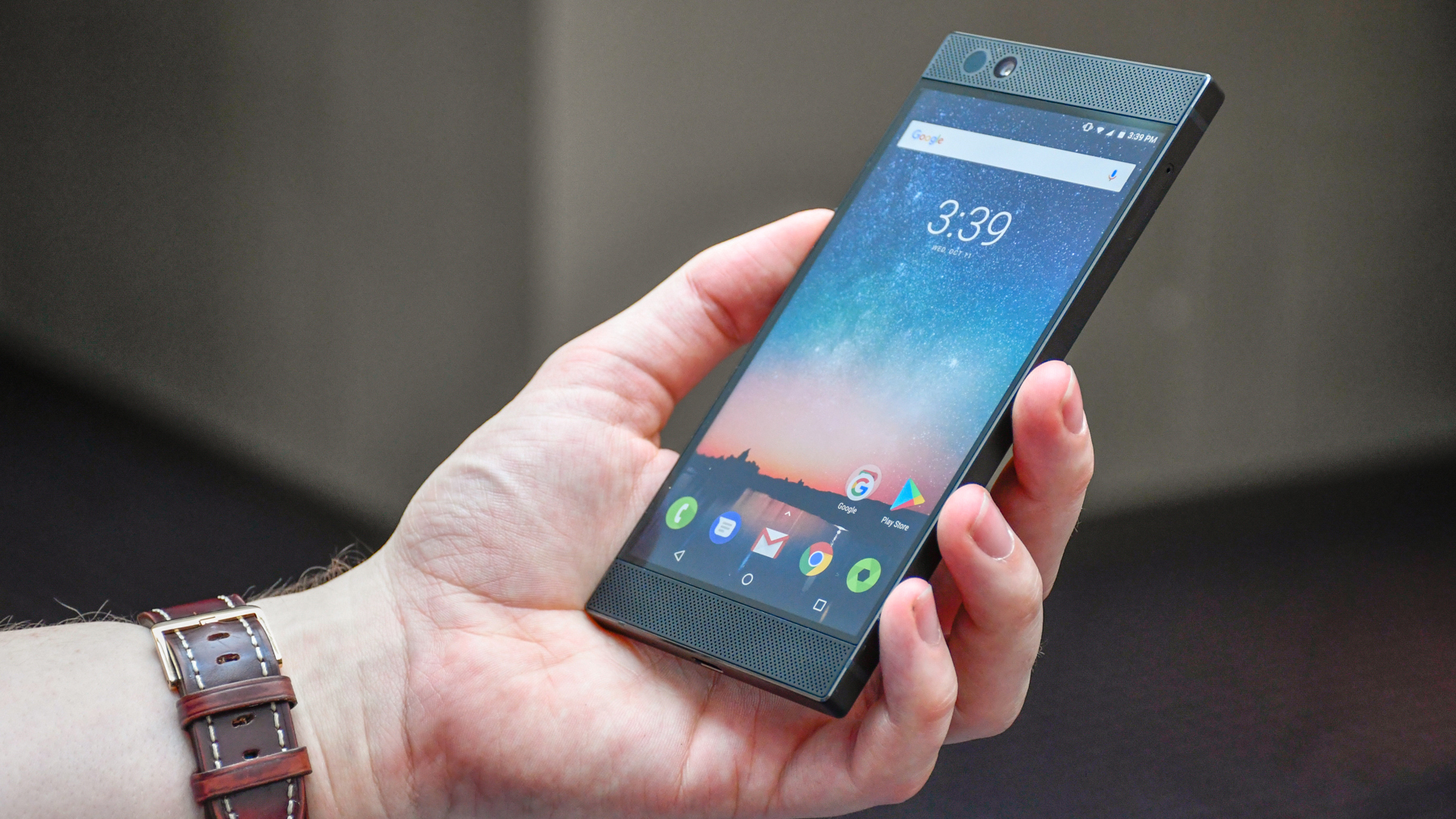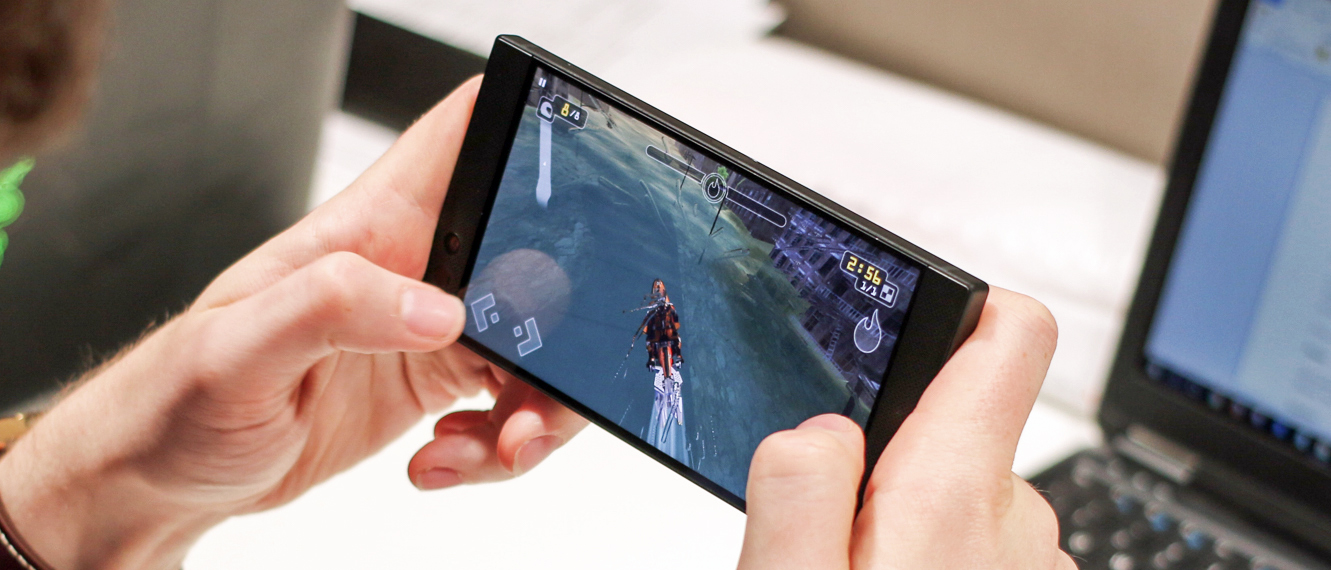TechRadar Verdict
The Razer Phone is packed full of power and potential, but the stumbling block is its niche appeal. Its design may not blow people away, but the super stereo speakers and gaming-focused display will appeal to some.
Pros
- +
Excellent speakers
- +
Display tuned for gaming
- +
Plenty of power under the hood
Cons
- -
Camera a weak point
- -
Only a handful of games
- -
No headphone jack
Why you can trust TechRadar
The Razer Phone is built for gamers, with high-end specs, silky smooth screen and powerful stereo speakers. But do gamers want a smartphone dedicated to gaming?
[Update: Razer has been plenty busy issuing updates to its debut phone. The most recent is its jump up to Android Oreo 8.1, skipping the vanilla update entirely.]
With so much competition at the top end of the mobile market, and flagship handsets already offering great screens and a whole lot of power for gaming, the Razer Phone is a bold play from a firm well known for its gaming laptops and peripherals, and which is now hoping its legions of fans will buy into its latest device.
This Android phone is focused on two core elements: the screen and the sound.
Its 5.7-inch display packs the world’s first 120Hz refresh rate on a smartphone, and it’s flanked by Dolby Atmos-tuned stereo speakers. The result is a handset that boasts some seriously strong credentials when it comes to visuals and audio, and with plenty of power under the hood.
Check out our review of the Razers design and screen below.
Razer Phone price and availability
- Launch price: $699, £699.99, AU$1,099 SIM-free
- Release date: November 2017
Weight: 197g
DimensionS: 158.5 x 77.7 x 8mm
OS: Android 8.1
Screen size: 5.7 inches
Resolution: 1440 x 2560
CPU: Snapdragon 835
RAM: 8GB
Storage: 64GB
Battery: 4,000mAh
Rear camera: 12MP + 12MP
Front camera: 8MP
The Razer Phone price is $699, £699.99, AU$1,099 SIM-free, putting it up against some of the best phones of the market including the Samsung Galaxy S8, iPhone 8, LG V30 and Google Pixel 2.
You can pick it up from Razer’s online store in the US at Best Buy, Amazon and the Microsoft Store, while those in the UK also have the option it grab it on contact exclusively at Three. In the US, you’ll have to buy it at full price.
Three is also offering the Razer Phone for £594.99 on PAYG (pay as you go) with at least a £10 top-up, which brings the price of the handset down by almost £100.
The Razer Phone release date was November 17 in a number of countries including the US, UK and Canada and launched in Australia on June 30, 2018.
Razer told us that, while a Middle East launch is a possibility later alonge the line, it has no plans to launch the handset in India.
As always, it's worth checking out the Razer promo codes currently available to see how you can save more.

Display
- World's first 120Hz smartphone gaming display
- 5.7-inch LCD IGZO QHD (1440 x 2560)
Razer started with the screen when it came to build the Razer Phone, as it’s essential to the gaming experience – and it provides an experience you can’t get on any other phone in 2017.
On paper, the 5.7-inch LCD IGZO QHD (1440 x 2560) display protected by Gorilla Glass 3 may not seem like anything special, putting it on a par with many of its rivals in terms of size and resolution; however there’s more to this screen than meets the eye.
Razer has opted for LCD technology over the brighter, more colorful AMOLED tech you’ll find in the likes of the Galaxy S8 and Google Pixel 2 XL because it has the ability to deliver higher refresh rates and frame rates. That’s ideal, of course, for 3D gaming.
The result is a display which boasts a 120Hz variable refresh rate, and is capable of up to 120fps (frames per second). It means movement on screen is silky smooth – even just scrolling through your Twitter timeline you can appreciate the higher frame rate as it glides effortlessly, and more quickly, beneath your fingers.

Dive into the settings and you can select the refresh rate you want for the display, with 60Hz, 90hz and 120Hz being your options. Increasing the refresh rate sees scrolling become smoother, and animations (app opening and so on) slicker.
Flicking between refresh rates and performing the same action (such as scrolling through your Twitter feed) does present a smoother, more satisfying experience at 120Hz, but those without a keen eye on refresh rates will find the difference minimal.
Of course, the main reason for that fast refresh rate is gaming, and we’ll cover that in more detail on the next page of this review.
Razer fans will likely appreciate what’s being offered here, but it’s difficult to make a case for why this phone is worth the money for more general users. If feels more like a ‘nice to have’ device than a game-changer.
Dive into the settings and you can opt to downscale the display resolution to Full HD (1080p), which improves battery life.
However, we found the Razer Phone’s battery lasted a full day on a single charge pretty comfortably, so we didn’t require this function.
The screen is crisp, clear and bright, which ensures everything looks great, from text to pictures to video.

TechRadar's former Global Managing Editor, John has been a technology journalist for more than a decade, and over the years has built up a vast knowledge of the tech industry. He’s interviewed CEOs from some of the world’s biggest tech firms, visited their HQs, and appeared on live TV and radio, including Sky News, BBC News, BBC World News, Al Jazeera, LBC, and BBC Radio 4.
